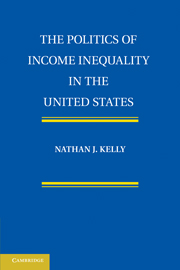Book contents
- Frontmatter
- Contents
- List of Figures
- List of Tables
- Acknowledgments
- 1 Explaining Income Inequality
- 2 The Distributional Force of Government
- 3 Political Conflict over “Who Gets What?”
- 4 Party Dynamics and Income Inequality
- 5 Macro Policy and Distributional Processes
- 6 Putting the Pieces Together: Who Gets What and How
- 7 Distribution, Redistribution, and the Future of American Politics
- Appendix A Congressional Questionnaire
- Appendix B Measuring Income Inequality over Time
- Bibliography
- Index
Appendix B - Measuring Income Inequality over Time
Published online by Cambridge University Press: 24 October 2009
- Frontmatter
- Contents
- List of Figures
- List of Tables
- Acknowledgments
- 1 Explaining Income Inequality
- 2 The Distributional Force of Government
- 3 Political Conflict over “Who Gets What?”
- 4 Party Dynamics and Income Inequality
- 5 Macro Policy and Distributional Processes
- 6 Putting the Pieces Together: Who Gets What and How
- 7 Distribution, Redistribution, and the Future of American Politics
- Appendix A Congressional Questionnaire
- Appendix B Measuring Income Inequality over Time
- Bibliography
- Index
Summary
The analysis focuses on three concepts related to the two stages of the distributional process – pre-redistribution inequality, post-government inequality, and explicit government redistribution. Measuring the concepts is a relatively straightforward undertaking in the static context of the year 2000. Data from the U.S. Census Bureau provides a wealth of information about income at the household level. In the 2000 data, for example, we can learn with a reasonable degree of precision how much income each household received from a wide variety of sources, such as wages, Social Security, dividends, Medicare benefits, and unemployment. There are also reasonable estimates of taxes that were paid within a household. Based on these data, the pre-redistribution income of each household can be computed by excluding income from all government sources. Post-government income can be computed for each household by including income from government sources and accounting for the amount of federal taxes paid. With household level data on pre-redistribution income and post-government income, a measure of inequality can be calculated for each income concept, and the redistributional impact of government can be calculated by finding the difference between pre-redistribution inequality and post-government inequality. Government redistribution could then be reported in absolute or proportional terms.
This procedure works quite well going back in time to the late 1970s. Prior to 1979, however, less detailed income data were collected. The further one goes back in time, the less detailed the income data become.
- Type
- Chapter
- Information
- The Politics of Income Inequality in the United States , pp. 177 - 184Publisher: Cambridge University PressPrint publication year: 2009



